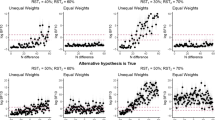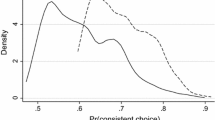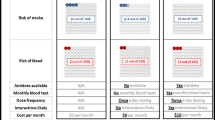Abstract
A new test procedure revealing mutuallyinconsistent choices has been developed andapplied to Stated Choice data. Our analysisshows that inconsistent choices commonly occurin several Stated Choice tasks. An applicationof the test to the Norwegian Value of Timestudy data shows that failing to excludeinconsistent choices resulted in asubstantially higher Value of time. Theinconsistent choices were made by less educatedparticipants. As the tasks were undertaken inthe easy context of choosing travelalternatives with three attributes,practitioners of more complex and cognitivedemanding designs should be particularilyconcerned with these results.
Similar content being viewed by others
References
Adamowicz, W., J. Louviere and M. Williams (1994), ‘Combining Revealed and Stated Preference Methods for Valuing Environmental Amenities’, Journal of Environmental Economics and Management 26, 271–292.
Adamowicz, W., J. Swait, P. Boxall, J. Louviere and M. Williams (1997), ‘Perceptions versus Objective Measures of Environmental Quality in Combined Revealed and Stated Preference Models of Environmental Valuation’, Journal of Environmental Economics and Management 32, 65–84.
Adamowicz, W. L., P. Boxall, M. Williams and J. Louviere (1998), ‘Stated Preference Approaches to Measuring Passive use Values: Choice Experiments and Contingent Valuation’, American Journal of Agricultural Economics 80(1), 64–75.
Arrow, K., R. Solow, P. R. Portney, E. E. Leamer, R. Radner and H. Schuman (1993), ‘Report of the NOAA Panel on Contingent Valuation’, Federal Register, January 15, 58(10), 4601–4614.
Bates, J. J. (1994), Reflections on Stated Preferences: Theory and Practice. Paper presented on Seventh International Conference on Travel Behaviour, 13–16 June. Santiago, Chile.
Ben-Akiva, M. and S. R. Lerman (1985), Discrete Choice Analysis. The MIT Press.
Ben-Akiva, M. and T. Morikawa (1990), Estimation of Travel Demand Models from Multiple Data Sources. Paper presented at the 11th International Symposium on Transportation and Traffic Theory, Yokohama.
Bhat, C. R. (1995), ‘A Heteroscedastic Extreme Value Model of Intercity Travel Mode Choice’, Transportation Research B 29(6), 471–483.
Boxall, P. C., W. L. Adamowicz, J. Swait, M. Williams and J. Louviere (1996), ‘A Comparison of Stated Preference Methods for Environmental Valuation’, Ecological Economics 18(3), 243–253.
Boxall, P. C., W. L. Adamowicz and T. Tomasi (1996), ‘A Nonparametric Test of the Traditional Travel Cost Model’, Canadian Journal of Agricultural Economics 44, 183–193.
Boyle, K. J., F. R. Johnson, D. W. McCollum, W. H. Desvousges, R. W. Dunford and S. P. Hudson (1996), ‘Valuing Public Goods: Discrete versus Continuous Contingent-Valuation Responses’, Land Economics 72(3), 381–396.
Boyle, K. J., H. F. MacDonald, H. Cheng and D. W. McCollum (1998), ‘Bid Design and Yea Saying in Single-Bounded, Dichotomous-Choice Questions’, Land Economics 74(1), 49–64.
Bradley, M. and A. Daly (1992), Estimation of Logit Choice Models Using Mixed Stated Preference and Revealed Preference Information. Paper presented at the 6th international Conference on Travel Behaviour, Quebec.
Bradley, M. and A. Daly (1994), ‘Use of the Logit Scaling Approach to Test for Rank-Order and Fatigue Effects in Stated Preference Data’, Transportation 21(2), 167–184.
Crocker, J. and C. L. Kling (2000), ‘Nonparametric Bounds on Welfare Measures: a New Tool for Nonmarket Valuation’, Journal of Environmental Economics and Management 39, 145–161.
Daly, A. J. (1992), ALOGIT 3.2. User’s Guide. The Hague: Hague Consuting Group.
Dawes, R. (1964), ‘Social Selection Based on Multidimensional Choice’, Journal of Abnormal and Social Psychology 68, 104–109.
Diamond, P. A. and J. A. Hausman (1994), ‘Contingent Valuation: Is Some Number Better Than No Number?’, Journal of Economic Perspectives 8(4), 45–64.
Dubourg, W. R., M.W. Jones-Lee and G. Loomes (1997), ‘Imprecise Preferences and Survey Design in Contingent Valuation’, Economica 64, 681–702.
Du Preez, J. P. (1994), ‘On Statistical Testing for Intransitivity in Multiattribute Consumer Preference Surveys’, Operations Research 42(3), 550–555.
Foster, V. and S. Mourato (1997), Are Consumers Rational? Evidence from a Contingent Ranking Experiment. Paper presented at the 8th Annual Conference of the European Association of Environmental and Resource Economists, Tilburg, The Netherlands, 26–28 June.
Frykblom, P. (1997), ‘Hypothetical Question Modes and Real Willingness to Pay’, Journal of Environmental Economics and Management 34(3), 275–287.
Green, D., K. E. Jacowitz, D. Kahneman and D. McFadden (1998), ‘Referendum Contingent Valuation, Anchoring, and Willingness to Pay for Public Goods’, Resource and Energy Economics 20(2), 85–116.
Halvorsen, B. and K. Sælensminde (1998), ‘Differences between Willingness-to-Pay Estimates from Open-Ended and Diskrete Choice Contingent Valuation Method: The Effect of Heteroscedasticity’, Land Economics 74(2), 262–282.
Hanemann, W. M. (1994), ‘Valuing the Environment Through Contingent Valuation’, Journal of Economic Perspectives 8(4), 19–43.
Hanley, N., R. E. Wright and V. Adamowicz (1998), ‘Using Choice Experiments to Value the Environment’, Environmental End Resource Economics 11(3–4), 413–428.
Hensher, D. A. (1994), ‘Stated Preference Analysis of Travel Choices: The State of Practice’, Transportation 21(2), 1994.
Hensher, D. A. and M. Bradley (1993), ‘Using Stated Choice Data to Enrich Revealed Preference Discrete Choice Models’, Marketing Letters 4(2), 139–152.
Hensher, D. A., J. Louviere and J. Swait (1997), Combining Sources of Preference Data: The Case of the Lurking ?’s. Working paper 97–8, Institute of Transport Studies, Sydney.
Hensher, D. A., J. Louviere and J. Swait (1999), ‘Combining Sources of Preference Data’, Journal of Econometrics 89, 197–221.
Johnson, F. R. and W. H. Desvousges (1997), ‘Estimating Stated Preferences with Rated-Pair Data: Environmental, Health, and Employment Effects of Energy Programs’, Journal of Environmental Economics and Management 34(1), 79–99.
Kim, K-S. (1998), Analysing Repeated Measurement Problems in SP Data Modelling. Paper presented at the 8th World Conference on Transport Research (WCTR), Antwerp, July 12–17.
Layard, R. and S. Glaister (1994), Cost-Benefit Analysis. Cambridge University Press.
Manski, C. (1977), ‘The Structure of Random Utility Models’, Theory and Decision 8, 229–254.
Mazzotta, M. J. and J. J. Opaluch (1995), ‘Decision Making When Choices are Complex: A Test of Heiner’s Hypothesis’, Land Economics 71(4), 500–515.
McFadden, D. (1973), ‘Conditional Logit Analysis of Qualitative Choice Behavior’, in P. Zaremmbka, ed., Frontiers in Econometrics. New York: Academic Press.
Neill, H. R. (1995), ‘The Context for Substitutes in CVM Studies: Some Emperical Observations’, Journal of Environmental Economics and Management 29, 393–397.
OrtÚzar, J. de D., D. A. Roncagliolo and U. C. Velarde (1997), Interactions and independence in Stated Preference Modelling. Proceedings from the 25th European Transport Forum, vol. P415, pp. 143–157.
Ouwersloot, H. and P. Rietveld (1996), ‘Stated Choice Experiments with Repeated Observations’, Journal of Transport Economics and Policy (May), 203–212.
Portney, P. R. (1994), ‘The Contingent Valuation Debate: Why Economists Should Care’, Journal of Economic Perspectives 8(4), 3–18.
Ramjerdi, F. L. Rand, I. A. F. Sætermo and K. Sælensminde (1997), The Norwegian Value of Time Study. Report no. 379/1997, Institute of Transport Economics, Oslo.
Randall, A. (1997), ‘The NOAA Panel Report: A Beginning or the End of an Era?’, American Journal of Agricultural Economics 79(5), 1489–1494.
Roe, B., K. J. Boyle and M. F. Teisl (1996), ‘Using Conjoint Analysis to Derive Estimates of Compensating Variation’, Journal of Environmental Economics and Management 31(2), 145–159.
Spash, C. L. and N. Hanley (1995), ‘Preferences, Information and Biodiversity Preservation’, Ecological Economics 12, 191–208.
Stevens, T. H., J. Echevarria, R. J. Glass, T. Hager and T. A. More (1991), ‘Measuring the Existence Value of Wildlife: What do CVM Estimates Really Show?’, Land Economics 67(4), 390–400.
Swait, J. (2001), ‘A Non-Compensatory Choice Model Incorporating Attribute Cutoffs’, Transportation Research Part B 35, 903–928.
Swait, J. and W. Adamowicz (1996), The Effect of Choice Environment and Task Demands on Consumer Behavior: Discriminating between Contribution and Confusion. Working Paper, Dept. of Rural Economy, University of Alberta, June.
Swait, J. and W. Adamowicz (1999), Choice Task Complexity and Decision Strategy Selection. Working paper, Dept. of Marketing, College of Business Administration, University of Florida, Gainesville, September.
Swait, J. and A. Bernardino (2000), ‘Distinguishing Taste Variation from Error Structure in Discrete Choice Data’, Transportation Research Part B 34, 1–15.
Sælensminde, K. (1995), Pakkeeffekter og budsjettpåminnelse - Hvordan påvirkes verdsettingen av redusert reisetid i den norske tidsverdistudien? (Effects of Packaging and a Budget Reminder on the Valuation av Reduced Travel Time). Working paper TP/0934/1995, Institute of Transport Economics, Oslo (in Norwegian).
Sælensminde, K. (1998), The Impact of Choice inconsistencies on the Valuation of Travel Time in Stated Choice Studies. Paper presented at the First World Congress of Environmental and Resource Economists, Venice June 25–27.
Sælensminde, K. (1999), ‘Stated Choice Valuation of Urban Traffic Pollution’, Transportation Research Part D 4, 13–27.
Sælensminde, K. (2001), ‘Inconsistent Choices in Stated Choice Data. Use of the Logit Scaling Approach to Handle Resulting Variance Increases’, Transportation 28, 269–296.
Sælensminde, K. and F. Hammer (1994), Verdsetting av miljøgoder ved bruk av samvalganalyse (Assessing Environmental Benefits by Means of Conjoint Analysis). TØI-rapport no. 251/1994, Institute of transport economics, Oslo (in Norwegian, with English summary).
Toner, J. P., S. D. Clark, S. M. Grant-Muller and A. S. Fowkes (1998), Anything You Can Do, We Can Do Better: A Provocative Introduction to a New Approach to Stated Preference Design. Paper presented at the 8th World Conference on Transport Research (WCTR), Antwerp, July 12–17.
Tversky, A. (1972), ‘Elimination-by-Aspects: A Theory of Choice’, Psychology Review 79, 281–299.
Varian, H. R. (1982), ‘The Nonparametric Approach to Demand Analysis’, Econometrica 50(4), 945–973.
Varian, H. R. (1983), ‘Nonparametric Tests of Consumer Behavior’, Review of Economic Studies 50, 99–110.
Widlert, S. (1994), Stated Preference Studies - The Design Affects the Results. Paper presented on Seventh International Conference on Travel Behaviour, 13–16 June. Santiago, Chile.
Widlert, S., G. Lind, E. Lindqvist, J. Lindqvist and U. Lindstedt (1993), Värdering av miljöfaktorer, Transek. Stockholm.
Author information
Authors and Affiliations
Rights and permissions
About this article
Cite this article
Sælensminde, K. The Impact of Choice Inconsistencies in Stated Choice Studies. Environmental and Resource Economics 23, 403–420 (2002). https://doi.org/10.1023/A:1021358826808
Issue Date:
DOI: https://doi.org/10.1023/A:1021358826808




